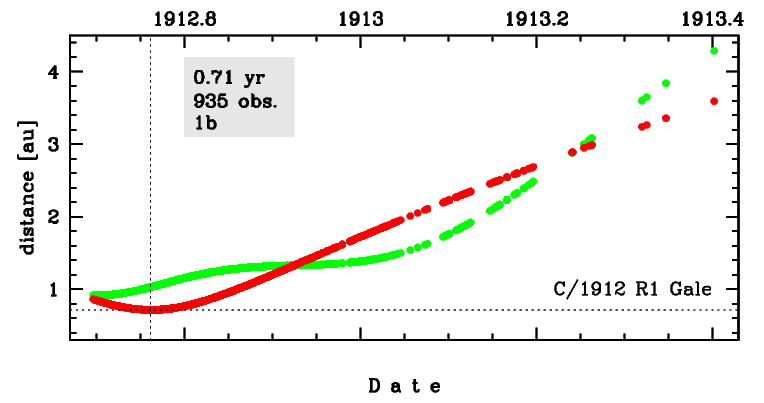C/1912 R1 Gale
more info
Comet C/1912 R1 was discovered on 9 September 1912 by Walter Frederick Gale (Sydney, New Aouth Wales, Australia), that is about one month before its perihelion passage, and it was last seen on 26 May 1913 [Kronk, Cometography: Volume 3].
This comet made its closest approach to the Earth on 14 September 1907 (0.920 au), that is five days after its discovery.
Solution given here is based on data spanning over 0.704 yr in a range of heliocentric distances from 1.366 au through perihelion (0.716 au) to 1.747 au.
This Oort spike comet suffers moderate planetary perturbations during its passage through the planetary system that lead to escape the comet from the planetary zone on a hyperbolic orbit (see future barycentric orbit).
More details in Królikowska et al. 2014.
This comet made its closest approach to the Earth on 14 September 1907 (0.920 au), that is five days after its discovery.
Solution given here is based on data spanning over 0.704 yr in a range of heliocentric distances from 1.366 au through perihelion (0.716 au) to 1.747 au.
This Oort spike comet suffers moderate planetary perturbations during its passage through the planetary system that lead to escape the comet from the planetary zone on a hyperbolic orbit (see future barycentric orbit).
More details in Królikowska et al. 2014.
| solution description | ||
|---|---|---|
| number of observations | 935 | |
| data interval | 1912 09 11 – 1913 05 26 | |
| data type | significantly more measurements after perihelion (POST+) | |
| data arc selection | entire data set (STD) | |
| range of heliocentric distances | 0.86 au – 0.72 au (perihelion) – 3.59 au | |
| detectability of NG effects in the comet's motion | NG effects not determinable | |
| type of model of motion | GR - gravitational orbit | |
| data weighting | YES | |
| number of residuals | 1670 | |
| RMS [arcseconds] | 2.48 | |
| orbit quality class | 1b | |
| next orbit statistics, both Galactic and stellar perturbations were taken into account | ||
|---|---|---|
| no. of returning VCs in the swarm | 0 | |
| no. of escaping VCs in the swarm | 5001 | |
| no. of hyperbolas among escaping VCs in the swarm | 5001 | * |
| next reciprocal semi-major axis [10-6 au-1] | -377.42 – -370.76 – -364.04 | |
| next perihelion distance [au] | 1.14 – 1.16 – 1.17 | |
| synchronous stop epoch [Myr] | 0.899 | S |
| percentage of VCs with qnext < 10 | 100 | |
| next_g orbit statistics, here only the Galactic tide has been included | ||
|---|---|---|
| no. of returning VCs in the swarm | 0 | |
| no. of escaping VCs in the swarm | 5001 | |
| no. of hyperbolas among escaping VCs in the swarm | 5001 | * |
| next reciprocal semi-major axis [10-6 au-1] | -377.41 – -370.75 – -364.03 | |
| next perihelion distance [au] | 1.18 – 1.2 – 1.22 | |
| synchronous stop epoch [Myr] | 0.896 | S |
| percentage of VCs with qnext < 10 | 100 | |
